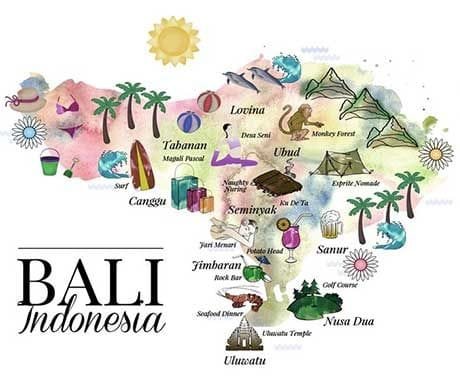The Beauty of Balinese Handicrafts: A Celebration of Artistry and Culture in Bali, Indonesia
Bali, the enchanting “Island of the Gods,” is not just a paradise for beach lovers but also a cultural hub celebrated for its artistry. The vibrant traditions and creative spirit of the island are best captured through its Balinese handicrafts, which range from stunning wood carvings to intricate batik textiles. These crafts are more than mere products; they are a testament to the island’s history, culture, and religious beliefs. Whether you’re decorating your home, searching for unique souvenirs, or supporting sustainable practices, Balinese handicrafts offer something extraordinary.
Discover Bali’s Handicrafts: The Essence of Balinese Artisanship
The mastery of Bali’s artisans has been passed down through generations, making the island a center of handicraft products that are both beautiful and functional. The tradition of creating Balinese handicrafts thrives in cultural hubs like Ubud, Gianyar, and Celuk, where artisans specialize in various crafts such as wood carving, silver jewelry, and woven baskets.
Every piece of Balinese handicraft tells a story, often influenced by the island’s Hindu traditions, Balinese mythology, and natural surroundings. From intricately carved wooden statues to handwoven textiles, these crafts reflect the dedication and artistic prowess of Bali’s culture.
Balinese Handicrafts – A Fusion of Tradition and Creativity
A Timeless Heritage
The art of making Balinese handicrafts dates back centuries, rooted in the island’s religious practices and daily life. Many crafts were originally created for religious ceremonies, such as hand-carved statues for temples and woven offerings for festivals. Over time, these traditional practices evolved to include more decorative and practical uses, catering to modern tastes without losing their cultural essence.
Modern Influences on Traditional Balinese Crafts
While Balinese handicrafts are steeped in tradition, modern influences have added new dimensions. Artisans today incorporate contemporary designs and techniques to appeal to international markets. However, the core values of sustainability, craftsmanship, and cultural storytelling remain intact.
The Rich Diversity of Balinese Handicrafts
Bali’s crafts are as diverse as its landscapes. Here’s an in-depth look at the various types of Balinese handicrafts and their significance:
Balinese Wood Carving – The Art of Intricate Detailing
Balinese wood carving is a signature craft of the island, known for its intricate patterns and cultural motifs. Villages like Mas specialize in creating hand-carved wooden statues that depict deities, mythical creatures, and nature-inspired designs. These carvings are often used in religious ceremonies or as decor in homes and temples.
- Materials Used: Teak, mahogany, and sandalwood are popular choices for their durability and fine grain.
- Popular Items: Decorative panels, masks, Ganesh statues, and furniture.
- Symbolism: Each carving carries symbolic meaning, often representing protection, prosperity, or harmony.
Balinese Textiles: Songket, Ikat, and Batik
Textiles are an essential part of Balinese culture, often used in ceremonies and daily life. The techniques involved in creating these fabrics are labor-intensive, requiring both skill and patience.
- Songket: A luxurious handwoven fabric with gold or silver threads, often worn during special occasions.
- Ikat: A dyeing technique where threads are dyed before weaving, creating unique, blurred patterns.
- Batik: The wax-resist dyeing method results in intricate, colorful designs that are perfect for clothing or home decor.
These textiles are highly sought after for their beauty and cultural significance, making them popular souvenirs.
Celuk Village – A Haven for Silver Jewelry
In the heart of Bali’s Gianyar district, Celuk Village is renowned for its silver jewelry. The artisans here create necklaces, bracelets, and rings with intricate patterns, often inspired by nature or Balinese mythology. Each piece is crafted with precision, making them not just accessories but true works of art.
Balinese Ceramics and Pottery
Pottery in Bali blends functionality with artistry, producing items like vases, bowls, and utensils that are both practical and beautiful. These pieces often feature hand-painted designs or mosaic details, making them ideal for Bali home decor.
- Eco-Friendly Materials: Clay and natural dyes are commonly used, ensuring sustainability.
- Symbolism: Many pottery items are decorated with motifs that reflect spiritual or cultural themes.
Woven Baskets and Bamboo Crafts
Bali’s woven baskets and bamboo crafts are perfect examples of how artisans utilize natural materials. These handmade items are not only practical but also eco-friendly.
- Usage: Storage, decoration, and ceremonial purposes.
- Styles: Traditional woven baskets often feature geometric patterns and vibrant colors.
The Value of Balinese Handicrafts
Supporting Local Artisans and Communities
Purchasing Balinese handicrafts directly supports local artisans and their families, helping preserve traditional skills. This also contributes to the island’s economy, ensuring that Bali’s culture continues to thrive.
Sustainable and Eco-Friendly Creations
Many artisans use sustainable practices, such as sourcing local materials and minimizing waste. By choosing Balinese handicrafts, you’re making an environmentally conscious decision.Unique Souvenirs and Mementos
Unlike mass-produced items, Balinese handicrafts are often one-of-a-kind, with each piece reflecting the artisan’s creativity and skill. Whether it’s a hand-carved statue or a vibrant textile, these items serve as meaningful reminders of Bali.
Where to Find the Best Balinese Handicrafts
Ubud – Bali’s Artistic Epicenter
Ubud is the heart of Bali’s art scene, home to numerous galleries, markets, and workshops. Here, you’ll find a wide range of Balinese handicrafts, from wood carvings to Balinese paintings.
Gianyar – A Treasure Trove of Creativity
The district of Gianyar is renowned for its traditional crafts. Visiting this area offers the chance to see artisans at work and purchase authentic Balinese handicrafts directly from their creators.
Celuk Village – The Silver Jewelry Capital
As the go-to destination for silver craftsmanship, Celuk Village offers an array of stunning jewelry pieces that blend traditional designs with modern aesthetics.
According to Bali.com, Celuk, an artists’ village located in the Gianyar region near Ubud, is renowned for its stunning Balinese and contemporary silver and gold jewelry. The craft has been passed down through generations, with most artisans beginning their training at a young age. For over a century, Celuk has been celebrated as the silversmiths’ village.
Markets Around Bali
Local markets, such as those in Mas, Gianyar, and Ubud, are excellent places to explore a variety of Balinese handicrafts. These markets provide a vibrant shopping experience and the opportunity to interact with local artisans.
Conclusion
Balinese handicrafts are more than decorative items—they are a celebration of Bali’s culture, history, and artistry. Each piece reflects the island’s vibrant traditions and the creativity of its artisans. By choosing Balinese handicrafts, you’re not only acquiring a unique and beautiful item but also supporting sustainable practices and the preservation of traditional skills.
From wood carvings and batik textiles to silver jewelry and woven baskets, Balinese handicrafts offer something for everyone. Whether you’re a collector, a decorator, or a traveler looking for meaningful souvenirs, these creations bring the magic of Bali into your life. So, on your next visit to Bali, immerse yourself in the island’s artistry and take home a piece of its rich heritage.


